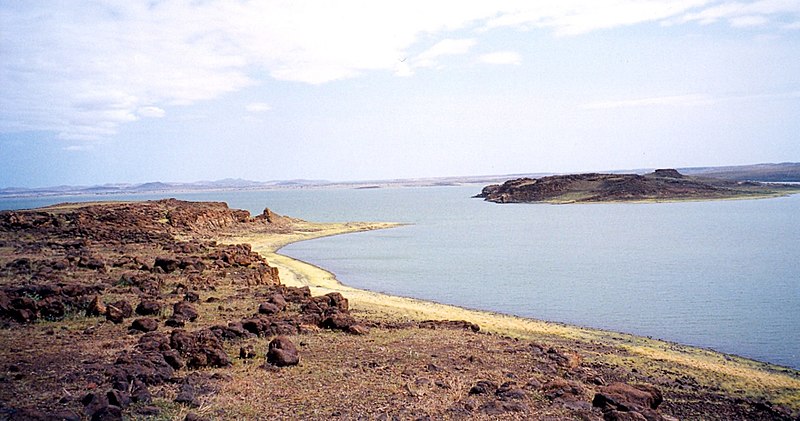Facts for Kids
Lake Turkana is a unique saline lake in the Kenyan Rift Valley famous for its turquoise color, rich biodiversity, and cultural significance.
Overview
Economic Importance
Cultural Significance
Geographical Location
Tourism And Recreation
Conservation Challenges
Historical Significance
Physical Characteristics
Biodiversity And Ecosystems
Climate And Weather Patterns
Local Communities And Livelihoods

Inside this Article
Great Rift Valley
Climate Change
Biodiversity
Temperature
Livestock
Crescent
Culture
People
Nature
Time
Are
Did you know?
🏞️ Lake Turkana is known as the 'Jade Sea' because of its beautiful turquoise color.
🧂 It is the largest desert lake in the world and has salty water!
🌍 This unique lake is located in the Great Rift Valley in northern Kenya and extends into Ethiopia.
🏔️ The lake sits around 370 meters (1,214 feet) above sea level and is surrounded by stunning mountains.
🌙 Lake Turkana covers an area of 6,405 square kilometers (2,477 square miles) and is shaped like a crescent.
🐠 At its deepest point, Lake Turkana reaches about 50 meters (164 feet)!
🌞 The climate is hot and dry, with temperatures reaching up to 40°C (104°F) in summer.
🐦 The lake is home to over 50 species of fish and attracts birds like flamingos and pelicans.
🌍 Local communities, such as the Turkana people, rely on the lake for fishing and water.
🏞️ Lake Turkana faces challenges like climate change and overfishing, making conservation important.
Introduction
️ Located in northern Kenya, it stretches over 250 kilometers (about 155 miles) long. This unique lake is special because it has salty water! 🧂
Lake Turkana is a favorite spot for scientists who study its unique ecosystem, making it an exciting place for learning about nature.
Economic Importance
️ Fishing is a major source of food and income for the communities nearby. The lake is also a place for agriculture, where people grow crops like maize and beans. 🌽
Many tourists visit the area, bringing in money for local businesses. Besides this, the lake has some potential for mining as well, making it a valuable resource.
Cultural Significance
They are known for their rich cultural traditions, including dances and unique clothing. The lake is also essential for fishing and gathering water! 🐟🎣 The local tribes hold cultural festivals and rituals, celebrating their connection to the lake. Lake Turkana has become a symbol of pride and identity for its people.
Geographical Location
It is found in northern Kenya and extends into Ethiopia’s border. It sits at about 370 meters (1,214 feet) above sea level. The lake is surrounded by beautiful mountains and deserts, providing a stunning view of the surrounding landscape! 🏔
️ Some nearby towns include Loyangalani and Kalokol, which have interesting cultures and histories.
Tourism And Recreation
You can enjoy activities like fishing, birdwatching, and even camping by the lake shore. Many people are drawn to the beautiful sunsets 🌅 and the chance to experience local culture through traditional craft markets. Annual festivals celebrating the lake’s rich heritage make it a popular destination for adventure travelers!
Conservation Challenges
️ Deforestation and overfishing also harm the lake’s ecosystem. It's essential to protect the lake by promoting sustainable fishing practices and conserving the surrounding environment. 🚫🐠 Organizations are working to preserve this unique habitat for wildlife and future generations to enjoy.
Historical Significance
Archaeologists have discovered tools and fossils dating back over 2 million years, revealing ancient human activities. This area is often called the "Cradle of Humanity" because some of the earliest human ancestors lived here. 🦴
These findings help scientists understand how humans developed over time, making the lake an exciting site for exploration!
Physical Characteristics
The lake's water is very salty, which makes it different from many other lakes. The water is warm, averaging about 28°C (82°F). At its deepest point, the lake reaches 50 meters (164 feet)! 🐠
Because of its unique salinity, the lake is home to special plants and animals that can thrive in such conditions.
Biodiversity And Ecosystems
The lake supports over 50 species of fish, including the Nile tilapia, and is famous for its tasty fish. 🐟
It also attracts birds like flamingos and pelicans, making it a birdwatcher's paradise! The nearby land is a semi-arid area that supports wildlife, including zebras, giraffes, and more! 🌾
This unique habitat makes Lake Turkana a treasure trove of biodiversity.
Climate And Weather Patterns
The temperature can reach up to 40°C (104°F) in the summer! Rainfall is very low, with only about 100 mm (4 inches) of rain each year. However, it gets cooler during the evenings! ❄
️ Local winds called "Turkana winds" can be strong, making it breezy. The weather can change quickly, so it's essential to stay prepared if you plan to visit!
Local Communities And Livelihoods
👩👧👦 Fishing provides food and income for many families, while some people engage in local artisan crafts. The Turkana people practice traditional herding, taking care of livestock like goats and camels. 🐪
They also promote eco-tourism to share their customs with visitors while protecting their natural environment. Lake Turkana is a vital part of their daily life, enriching their culture and livelihoods!

